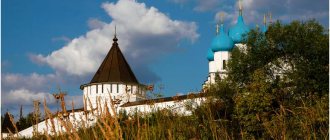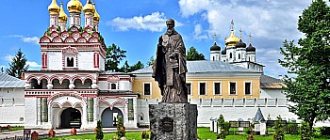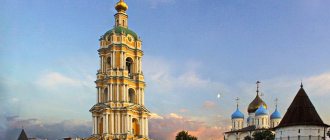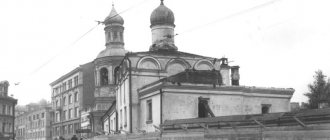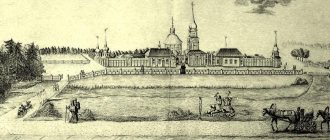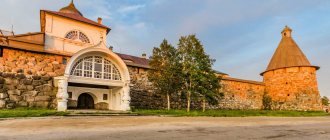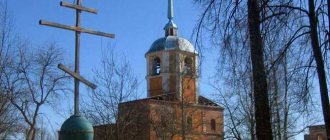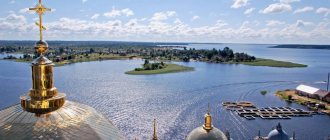An ancient monastery with a vague and long history. St. Andrew's Church is located in Moscow near the Sparrow Hills. The most beautiful view of the landmark opens from the Moscow River and Sparrow Hills. It is distinguished by the fact that the first educational school in Moscow for the laity was opened here in the middle of the 17th century. The tradition has still been preserved; the theological school at St. Andrew’s Monastery operates and to this day regularly recruits and trains students in the main areas. St. Andrew's Monastery is located in a quiet, cozy place, hidden in greenery and new buildings.
© Oleg N.
Story
The building has seen many events and was repurposed several times: there was a prison, an insane asylum, an orphanage, an almshouse, a metrology laboratory, a club, and communal houses.
Until the end of the 16th century, the area near the Sparrow Hills and the river was empty. In 1591, Moscow was liberated from the invasion of Khan Kyzy-Girey, and this happened on the day of the martyr Andrei Stratilates. In honor of this event, a wooden temple was erected, which in 1675 was replaced by a stone one. It was named in the name of the holy martyr Andrew Stratilates, which is why the monastery is called “Andreevsky”. During the 18th century, the monastery was reoriented and closed three times. The documents found from that time indicated: “Former St. Andrew’s Monastery,” that is, abolished.
In 1900, abbot Nikolai Molchanov opened a parochial school at the monastery; it closed in 1918, after which the Moscow factory commune houses were located in the buildings, and a club was opened in 1925. From 1967 to 1971, work was carried out to restore the object. And only in 1996 the Moscow government decided to transfer St. Andrew's Monastery to the Russian Orthodox Church for indefinite use.
© ComradeSany
Architecture and territory
In 1648 the Church of the Resurrection was built, in 1675 - the Church of the Martyr Andrew Stratilates. The facade of the second church was created by Belarusian craftsmen. Not far from the Church of the Resurrection, work was carried out on the construction of the Church of the Intercession, but it was soon demolished, and the construction of buildings began in its place. In 1748, a bell tower appeared on the territory by order of Count Sheremetev. Initially, it was tetrahedral with arched openings and a hipped tent, on top of which there was a ball and a cross. In the bell tower itself, in the lower tier, the Church of St. John the Evangelist was opened.
Now the monastery is a rectangular structure consisting of several buildings. Inside there is a bell tower built in the 17th century in the Baroque style (it was rebuilt in the 18th century). It is decorated with capitals, cornices, slotted windows, and stucco moldings. Under the bell tower is the Church of the Archangel Michael. The Church of the Resurrection was restored, after which the decor under the dome changed, but the Naryshkin Baroque style was preserved. The gate temple of the martyr Stratelates underwent restoration in 1961, during which the decorative elements were slightly changed. Three almshouses have survived to this day since 1805.
At the beginning of the 21st century, the elite residential neighborhood “Green Hills” was built near the monastery, but the territory of the landmark remained untouched. Decorative shrubs, flowers, and a lawn are planted here; the area looks well-groomed, but very modest. In a small area there are fragments of an old cemetery, dungeons, and three temples.
Against the backdrop of the fast life of Moscow and the noisy Embankment, the landmark remains a quiet, calm and peaceful place where you can come and take a break from the bustle, visit a temple or just get acquainted with old architecture. Visitors can have a delicious lunch at the local inexpensive eatery.
St. Andrew's Monastery
Basic moments
The architectural ensemble of St. Andrew's Monastery took shape from the middle of the 17th century. Before the revolution, it was formed by 6 temples, but only three of them have survived to this day. The compact complex of buildings also includes a monolith of the same type of buildings of the St. Andrew's almshouse, built in the century before last.
The monastery looks most impressive from the side of the Moscow River, and during river excursions tourists do not miss the opportunity to capture its image in photos and videos from the deck of a pleasure boat. In the most comfortable monastery, peace and quiet reign. Even on the main church holidays it is not crowded here. The exception is summer weekends, when the St. Andrew's Monastery is visited by townspeople and guests of the capital intending to go on a free walking tour of the Sparrow Hills. Groups gather near the monastery walls.
History of St. Andrew's Monastery
Church tradition says that back in the 13th century, hermit monks founded a monastic monastery near the Sparrow Hills. And the wooden temple they built bore the name of Andrei Stratelates - a Christian saint, warrior-martyr. There is no documentary evidence confirming this legend, and the first written mentions of a chopped-down temple in honor of the patron saint Stratilates appeared in Moscow chronicles only in the 20s of the 17th century. They indicate that the church was erected after 1591, when the Khan of Gaza, Giray, hastily withdrew his troops from near Moscow, believing the false information of the spy. The official date of foundation of the St. Andrew's Monastery itself is considered to be 1648. Tsar Alexei Mikhailovich ordered it to be arranged.
Initially, the men's monastery was assigned the role of a center of education. In 1649, learned hieromonks, students of Metropolitan Peter Mohyla, arrived here from the Kiev-Pechersk Lavra. The monks who received an education at the Kyiv Theological Academy were charged with teaching the Moscow lay youth Latin, rhetoric, and teaching Greek and Slavic languages. For a substantial remuneration, educators translated the historical and philosophical works of Christian theologians, and then they were published by the Moscow printing house. The monks created the informal “St. Andrew’s Teaching Brotherhood,” which laid the foundation for the creation of academic structures in Moscow.
Until the 20s of the 18th century, St. Andrew's monastery flourished, owning lands, fish ponds, and mills. The construction within the walls of the monastery was financed by the royal treasury. It is known that the basements of the monastery often served as a dungeon. In 1667, the rebellious archpriest Avvakum, the ideologist of the Old Believer movement, languished here for a short time.
In 1724, Peter I ordered the abolition of St. Andrew's Monastery. The churches became parish churches, and other buildings housed an institution where street children and foundlings were kept. There was also a place here for the “block workers” prisoners. Later, Empress Anna Ioannovna ordered the restoration of the monastery, and the closure of the charitable institution and the prison. True, in 1762 the monastery was obliged to house the insane.
Two years later, the considerably impoverished monastery was included in the lists of secularization initiated by Catherine II. This time, a workhouse was organized in its buildings for women who had no means of subsistence. In 1771, during the plague epidemic, noble and wealthy Muscovites were buried on the territory of the monastery. This necropolis was destroyed in the 20-40s of the last century.
In 1806, the St. Andrew's almshouse, which was maintained by the Moscow merchant society, settled in the former monastery. At the expense of benefactors, new buildings were built here, fitting quite harmoniously into the previously created architectural ensemble.
In 1918, the almshouse was liquidated. In subsequent decades, the solid monastery buildings alternately housed commune houses and a vocational school of the Goznak factory, a club, and Gosstandart laboratories. In the 90s, the historical complex was transferred to the Russian Orthodox Church, and a patriarchal courtyard was opened here. In 2013, it was transformed into St. Andrew's Monastery.
Monastery today
St. Andrew's Monastery looks quite modest, but very well-groomed and peaceful. The architectural ensemble is a rectangle formed not by walls, but by building bodies. Three monastery churches are lined up in one line. The strict outlines of the complex are wonderfully visible from the bell tower of the Church of St. John the Evangelist and from the observation deck located above the monastery.
The tall buildings surrounding the temples were erected in different periods of the century before last, but their gable roofs were brought to a single level. The buildings facing the embankment have 3 floors, and those facing the slopes have two floors. The facades of the buildings facing the river look impressive, but from the side of the monastery courtyard the buildings look nondescript. The eastern facade of the architectural ensemble stands out, marked by the Church of St. Andrew Stratilates, which rises above the main entrance - the Holy Gate.
The stone gate church of St. Andrew Stratilates, erected in 1675 on the site of an old wooden church, is the oldest building of the monastery. The appearance of the church intertwined the elegant decor of the 17th century and classical features inherited from the construction and restoration work carried out in the monastery in 1805. The fresco painting decorating the arched openings of the Holy Gates dates back to the same time.
St. Andrew's Church is one of the unique monuments of Moscow architecture of the 17th century. It owes its fame to its authentic tiled decoration. Belarusian ceramists worked on it - students of Stepan Polubes, a brilliant tile maker who had his own workshop in Moscow. Spectacular tiled ornaments border the quadrangle of the church and the dome drum. They are intertwined with relief patterns known as "peacock's eye".
Before the revolution, the interiors of the gate church of St. Andrew's Monastery were magnificently decorated, and its iconostasis was of artistic value. But today there is nothing here that reminds us of its former luxury. Modest in size, dimly lit rooms are painted by contemporary artists. The subjects include the life of the Blessed Virgin Mary.
You can walk along the paved path to the bell tower, which is the heart of the architectural ensemble and its main decoration. The 32-meter belfry was erected in the middle of the 18th century at the expense of Count Sergei Sheremetev. Despite its monumentality, it looks quite elegant. The three-tier tower stands out with its expressive silhouette, representing an excellent example of post-Petrine baroque. Its elegant decor is dominated by yellow-pinkish color, which serves as a background for white stone elements and stucco molding. There are new bells installed here, cast in the Bavarian city of Passau, in the famous workshop of Rudolf Perner. Rumor has it that the monastery bell ringer is one of the best in the capital.
There is a temple on the first tier of the bell tower. It was erected in 1748, and a hundred years later it was rebuilt and consecrated in honor of St. John the Evangelist. It is not known what the decoration of the temple looked like before the revolution, but in some places fragments of stucco molding have been preserved in the interiors. Probably, at one time it completely covered the interior walls, and today restorers are working on restoring the stucco decoration.
In the western part of the monastery is its main temple, built at the turn of the 17th and 18th centuries and consecrated in the name of the Resurrection of Christ. Notable for its bright red color, the church faces the bell tower with its altar. The architectural appearance of the temple is distinguished by the contrast between the elegant lower level, made in the Naryshkin Baroque style, and the upper floor with emphatically strict forms.
In the spacious and bright Church of the Resurrection, the main restoration work was completed back in 2012. During their execution, a small fragment of authentic painting was exposed on the vault. But in general, the interiors of the temple were decorated by modern masters. The main monastery relics are kept here, including a life-size crucifix made of wood in the century before last, and the “Kazan” icon of the Mother of God.
Practical information
St. Andrew's Monastery is open to the public daily from 08:00 to 21:00. Divine services are held in all three churches.
On the territory of the monastery there is a refectory and a regular dining room, and there is a store where books, icons, and church utensils are sold.
A visit to the St. Andrew's Monastery is usually included in the program of excursions to the Novodevichy and Donskoy monasteries, located nearby.
How to get there
St. Andrew's Monastery is located at the address: Andreevskaya embankment, 2. The nearest metro stations are Vorobyovy Gory, Ploshchad Gagarin, Leninsky Prospekt. From them to the monastery you will have to walk 15 minutes. You can also go here by river bus, landing at the St. Andrew's Monastery pier. From the pier you also need to walk a bit.
What to see nearby
Those travelers who plan to visit the spiritual places of Moscow can develop their own route, including the Donskoy, Novodevichy, and St. Andrew's Monasteries. They are nearby. Tourists who plan to attend free excursions to the Sparrow Hills meet at the monastery several times a week in the summer and have the opportunity to explore the cozy area that reflects the life of the monks. If you are walking in Neskuchny Garden or Gorky Park, you can reach this attraction on foot. Above the monastery is the Vorobyovy Gory observation deck, which offers picturesque views of the Kremlin, Moscow City, Neskuchny Garden, and Moscow State University.
Monastery today
Nowadays, St. Andrew's Monastery has the status of a functioning monastery. It houses the Synodal Library and Sunday School. Believers and tourists can visit the monastery any day from morning to evening.
Visitors are asked to be respectful of the inhabitants living here and not to take photographs of monks, priests, services or the interiors of churches. In addition, when visiting monastery churches, tourists are asked not to forget to turn off their mobile phones.
Daily services are held at the Church of the Resurrection. On weekdays they start at 7.30 and 17.00, and on Sundays and holidays - at 9.00 and 17.00. The patronal feast day of St. Andrew of Crete is celebrated here on July 17. At the entrance to the monastery there are icon and book shops. Those who want to have lunch can do so in the paid refectory.
How to get to St. Andrew's Monastery
From the metro station "Leninsky Prospekt" (Kaluzhsko-Rizhskaya line) it takes 15 minutes on foot.
Bus No. 144, 255, M1, 905, T47, 308, 907, M6 stops directly at Andreevskaya Embankment. Within walking distance is the Khamovnichesky Val 2 stop, which can be reached by buses and minibuses No. 132, 255, 64. By bus No. 64, 216, 255, T79, C12 you should get to Luzhnetskaya Embankment, and across the bridge and the river will be St. Andrew's Monastery.
By taxi you can quickly get to the monastery gates from anywhere in the capital by ordering a car in the Uber, Yandex taxi, Maxim taxi, Gett applications. The following taxi services are available in Moscow: “Two Capitals”, “Cozy Taxi”, “Slavyanskoe”, “Taxi Orange”, Optimal, VeryWell.
